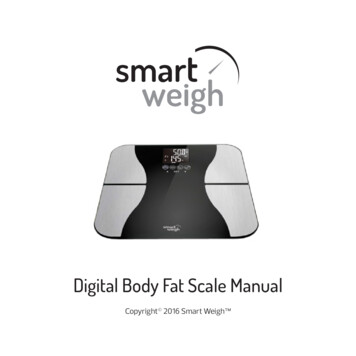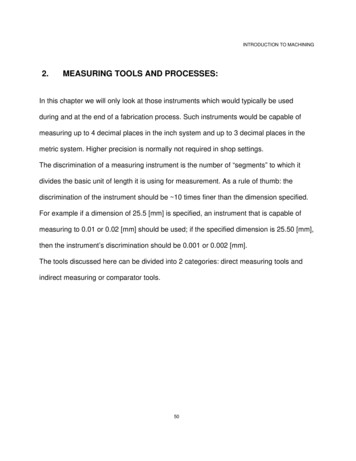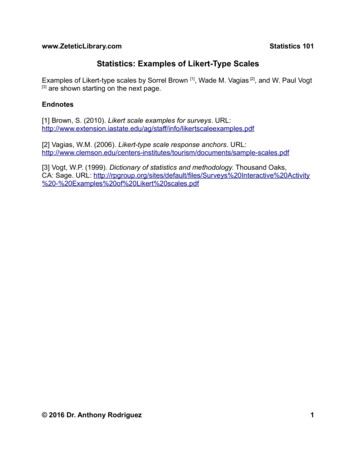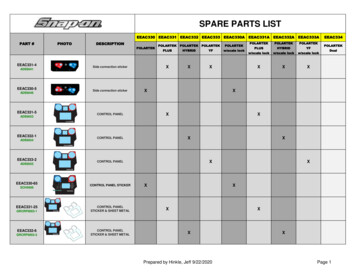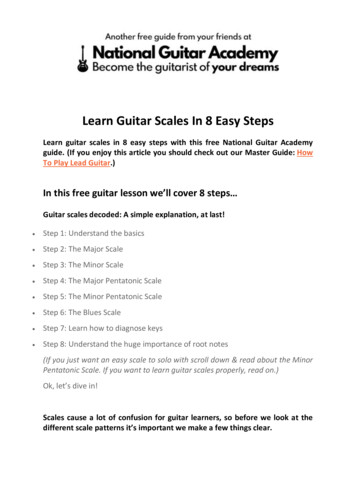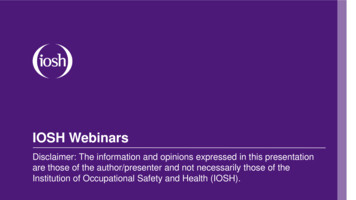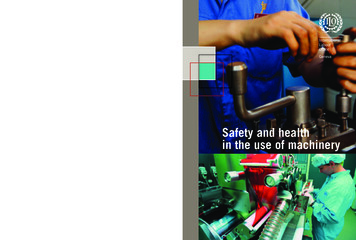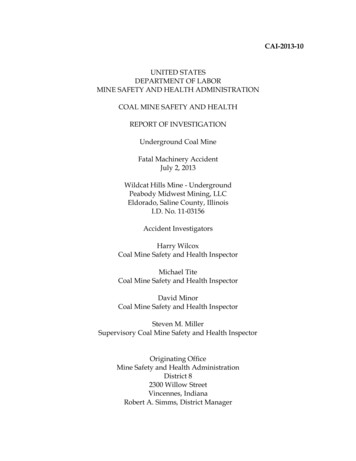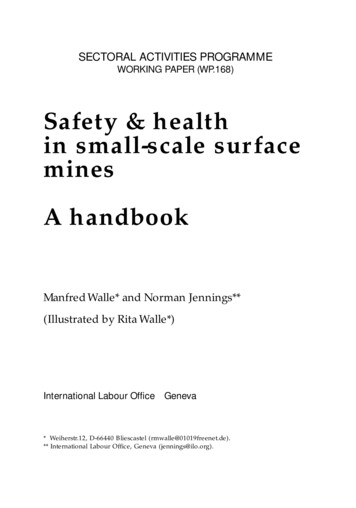
Transcription
SECTORAL ACTIVITIES PROGRAMMEWORKING PAPER (WP.168)Safety & healthin small-scale surfaceminesA handbookManfred Walle* and Norman Jennings**(Illustrated by Rita Walle*)International Labour OfficeGeneva* Weiherstr.12, D-66440 Bliescastel (rmwalle@01019freenet.de).** International Labour Office, Geneva (jennings@ilo.org).
Copyright International Labour Organization 2001Publications of the International Labour Office enjoy copyright under protocol 2 of the UniversalCopyright Convention. Nevertheless, short excerpts from them may be reproduced without authorization, on condition that the source is indicated. For rights of reproduction or translation, applicationshould be made to the Publications Bureau (Rights and Permissions), International Labour Office, CH1211 Geneva 22, Switzerland. The International Labour Office welcomes such applications.Libraries, institutions and other users registered in the United Kingdom with the Copyright LicensingAgency, 90 Tottenham Court Road, London W1P 0LP (Fax: 44(0)20 7631 5500), in the United Stateswith the Copyright Clearance Center, 222 Rosewood Drive, Danvers, MA 01923 (Fax: 1 978 750 4470),or in any other countries with associated Reproduction Rights Organizations, may make photocopies inaccordance with the licences issued to them for this purpose.ISBN 92-2-112475-4First published 2001The designations employed in ILO publications, which are in conformity with United Nations practice,and the presentation of material therein do not imply the expression of any opinion whatsoever on thepart of the International Labour Office concerning the legal status of any country, area or territory or ofits authorities, or concerning the delimitation of its frontiers.The responsibility for opinions expressed in signed articles, studies and other contributions rests solelywith their authors, and publication does not constitute an endorsement by the International LabourOffice of the opinions expressed in them.Reference to names of firms and commercial products and processes does not imply their endorsementby the International Labour Office, and any failure to mention a particular firm, commercial product orprocess is not a sign of disapproval.ILO publications can be obtained through major booksellers or ILO local offices in many countries, ordirect from ILO Publications, International Labour Office, CH-1211 Geneva 22, Switzerland. Cataloguesor lists of new publications are available free of charge from the above address.Printed in FranceBRI-SAD
PrefaceOccupational safety and health (OSH) are important issues for theworld’s 13 million or so small-scale miners — many of whom work insurface mines — and their communities.Progress in dealing with diseases and accidents affecting small-scaleminers will require a better understanding of the risks and hazards andof the practices and behaviour to prevent them. Better data will also berequired for improvement programmes to be targeted. This will meanhaving a simple form for reporting accidents and disease — somethingrecommended in this handbook.OSH regulations might need to be revised to ensure that the specialrequirements of small-scale miners are adequately covered. This handbook sets out some basic principles for use in the absence of specificregulations, or in conjunction with them.Mines’ inspectorates can play an important role in overseeing OSHin small-scale mines and in providing advice, as well as policing regulations. We hope that this handbook will be of use to them in their important task.Both mine owners/concession holders and mineworkers must behelped to realize that accident prevention and improved occupationalhealth are worth obtaining and worth keeping. Education, training,demonstration and surveillance are the keys to improving OSH in smallscale mining. But this is well known. The purpose of this handbook isto make a practical contribution to this process.The Office acknowledges with thanks the encouragement and financial support of Projekt-Consult GmbH, long active in working with smallscale miners, in the preparation of this handbook.Oscar de Vries ReilinghDirectorSectoral Activities Departmentiii
ContentsPagePreface . . . . . . . . . . . . . . . . . . . . . . . . . . . . . . . . . . iii1. Objectives, scope and definitions . . . . . . . . . . . . . . . . .12. General principles . . . . . . . . . . . . . . . . . . . . . . . . .33. General provisions . . . . . . . . . . . . . . . . . . . . . . . . .54. Mining accidents and dangerous occurrences . . . . . . . . . .95. Hazards in the working environment. . . . . . . . . . . . . . 116. Health, welfare and hygiene of mineworkers . . . . . . . . . . 177. First aid . . . . . . . . . . . . . . . . . . . . . . . . . . . . . . . 198. Personal protective equipment . . . . . . . . . . . . . . . . . . 239. Safety when mining . . . . . . . . . . . . . . . . . . . . . . . . 2710. Mechanical equipment. . . . . . . . . . . . . . . . . . . . . . 3911. Explosives and blasting . . . . . . . . . . . . . . . . . . . . . . 4512. Cessation of mining / mine closure. . . . . . . . . . . . . . . 51v
1. Objectives, scope and definitionsObjectivesThe objectives of this handbook are: To protect workers in small-scale surface (open-pit) mines fromsafety and health hazards and risks in their work.To prevent or reduce the incidence and severity of illness and injuryin small-scale surface mines.To promote training and consultation in improving safety and healthin small-scale surface mines.Good standards of safety and health can only be achieved ifeveryone is competent for the work they have to do and all worktogether, effectively, as a team.ScopeThe following guidelines apply to any situation or operation that affectsthe safety and health of those involved in small-scale surface mines. Theyare for mining operators, supervisors and mineworkers.The guidelines set out the basic requirements for protecting workers’safety and health and contain recommendations on good mining practices to be followed in order to protect safety and health.This handbook is not intended to replace applicable laws, regulations or accepted standards that set out higher requirements.1
DefinitionsSurface mine means an excavation in the earth conducted above ground(open-pit mine) for the purpose of opening-up, proving or producingany mineral from a natural deposit. It includes all facilities belonging toor used in connection with the mine.Mining authority means a government institution that is responsible forall or any part of occupational safety and health in mining.Mine operator means any individual or organization who operates, controls or supervises a mine, as an owner or lessee.Competent person means a person who, in the opinion of the mine operator and the mining authority, has adequate qualifications, such as suitable training and sufficient knowledge and skill, for the design, organization, supervision and safe performance of the duties for which he orshe is appointed.Hazard means the potential to cause injury or damage to the health ofpeople.Risk means the likelihood that something will occur causing injury ordamage to the health of people.2
2. General principlesThe application of these guidelines should take into account the following steps, in order of priority : Eliminating the risk.Controlling the risk at source.Minimizing the risk.Using personal protective equipment.Safety inspections should be carried out at regular intervals.Convention on Safety and Health in MinesThe ILO’s Convention on Safety and Health in Mines, 1995 (No. 176)covers all mines. It provides a floor — the minimum safety requirementagainst which all changes to mine operations should be measured. Theaccompanying Recommendation (No. 183) — which is advisory — provides more specific guidance on the different sections of the Convention.The Convention sets out procedures for reporting and investigating accidents and dangerous occurrences in mines. Governments that ratify itundertake to adopt legislation for its implementation, including the designation of the competent authority to monitor and regulate the variousaspects of safety and health in mines.More specific guidelines on safety and health in surface mines, mainlyfor larger scale operations, can be found in the ILO’s Code of practice onsafety and health in opencast mines.3
3. General provisionsDuties of the mine operatorThe mine operator should: Notify the mining authority before starting operations at any mineand before discontinuing or abandoning any existing miningactivity.Provide all the equipment, apparatus, facilities and finance toensure, as far as reasonably practicable, good mining practice andan appropriate standard of occupational safety and health at themine.Make sure everyone understands their safety and health responsibilities.Appoint, depending upon the number of mineworkers employedand the nature and extent of mining operations, one or more competent persons — supervisor — to supervise and control the operations at the mine.Encourage the workforce to be actively involved in safety andhealth.Requirements for employment in surface minesWork in a surface mine often has to be performed in a hostile and dangerous environment. It can be made safe and productive by continualhuman effort. Such efforts cannot succeed unless all workers have certain skills and a good knowledge of possible hazards and risks.It is therefore vital to have competent and experienced persons whoshould be constantly on the site of the mine to supervise and control theoperations and carry out regular inspections.Supervisors should have immediate charge of all persons employedwithin the mine area of operation and should be responsible for thesafety, health and welfare of all persons assigned to them.Each newly recruited mineworker should receive instructions, guidanceand supervision in their respective work from the supervisor and5
adequate on-the-job training before being starting work. This instructionshould include : Introduction to the working environment.Health and safety aspects of the task to be assigned.Hazard recognition and avoidance.Hazards relating to explosives.Ground control and working in areas of high walls.Hazards of machinery and equipment.Basic knowledge of first aid.No mineworker should be assigned to work alone in a remoteplace or where a hazard might exist.Obligations of mineworkersNo mineworker should take any action at work which could causedanger to other workers, damage to mining equipment or obstruct production.Every worker should fully comply with rules or instructions issued bythe mine operator and should make proper use of and take reasonablecare of any personal equipment provided for his protection.Action to prevent dangerEvery mineworker while at work should: 6Take reasonable care for the safety and health of himself or herselfand of other persons who may be affected by their acts or omissions.
Comply with instructions given for his own safety and health andthose of others.Report immediately to the supervisor any situation which he or sheconsiders hazardous and which he or she cannot correct themselves. If this measure cannot be taken, the mineworker shouldimmediately warn all workers who could be in danger.Report any accident, injury or dangerous occurrence which arises inthe course of or in connection with work.Every mineworker should leave the area as soon as possibleafter being warned of danger, except for rescue or first-aidworkers who may be required to assist in rescue work.Mine facilitiesAs far as possible, at or near every site where mining is regularly carriedout, there should be: A clearly marked storage facility for first-aid equipment.Somewhere to store safety and personal protection equipment.Secure storage for explosives and shot-firing equipment.Somewhere to store mining tools and equipment.Adequate washing, sanitary and changing facilities.Adequate accommodation for mineworkers when mining operationsare located in remote areas.Relations between the mine owner/operator and the workforceshould be based on regular consultation, consensus,and fairness.7
4. Mining accidents and dangerous occurrencesDefinitionsMining accident means any occupational injury to any person as a resultof mining work within the area of mining activity, for which medicaltreatment is administered or which results in loss of consciousness ordeath.Dangerous occurrence means any unplanned event at any mine that hasthe potential to cause an injury or disease to persons at work.A dangerous occurrence could be an event that: Substantially affects regular mining activity, such as: land slides; collapse of the working face; major fall of rock; inrush of water intothe mine; the unintentional ignition or detonation of explosives. Causes damage to or disrupts the operation of any vital miningmachinery or equipment, such as : explosion; fire ; bursting of apressure vessel. Requires the withdrawal of miners or any other emergency action. Endangers any individual at the mine.Response to mining accidents and dangerous occurrencesAt any mine where an accident or dangerous occurrence takes place, themine operator should ensure that: The necessary steps are taken to evacuate and treat injuredmineworkers and immediate action is taken to prevent furtherdanger arising from the event. An investigation into the cause of the mining accident or dangerousoccurrence is carried out and preventive action is taken to avoidsimilar events in the future.9
The result of the investigation is recorded in a book providedfor that purpose and the mining authority is notified aboutthe event.After a mining accident or dangerous occurrence, the miningauthority should assist the mine to ensure that improvedpractice will prevent it from happening again.10
5. Hazards in the working environmentIn the working environment of a surface mine airborne contaminants(such as rock dust and fumes), excessive noise, vibration, heat stress andergonomic problems can create health risks to mineworkers who aresubject to frequent and prolonged exposure to them.Dust and fumesDustAirborne contaminants, such as rock dust, are mainly produced duringdrilling operations, mineral getting, loading, crushing of rock or ore, andblasting. Persons exposed to excessive dust for prolonged periods maysuffer from permanent lung diseases, such as silicosis.As far as practicable, the escape of dust into the atmosphere should beprevented, particularly in stagnant zones.Dust should be controlled or suppressed by: Using wet drilling techniques.Using water sprays during mineral getting, loading, crushing.In general, any stone surface being worked should be kept moist toreduce the escape of dust into the atmosphere.Where such dust control measures are not provided or have notbeen developed, mineworkers exposed to excessive dustconcentrations in their working environment should always usepersonal protective equipment, such as dust masks,to prevent dust from being inhaled.11
Use water to suppress dust and/or wear a dust mask.Harmful fumesFumes, produced during shot-firing operations contain toxic gases (suchas sulphur dioxide, nitrous oxide, nitric oxide, etc.) which, when inhaled,can lead to serious health damage.Mineworkers should not approach a working face after shot-firing untilthe dust and gaseous products of the blast have completely dissipated.The exhaust from diesel engines also contains harmful fumes, includingvery fine, respirable particles. Frequent and prolonged exposure to dieselexhaust is a health risk and should be prevented.As far as practicable, stationary diesel equipment should not be operatedin stagnant zones or close to workplaces.Simple dust masks do not protect against toxic gases which arepresent in after-blast fumes or in diesel exhaust fumes.Persons should not work or travel where hazards may be created as aresult of impaired visibility due to dust or fumes.12
NoiseRepeated or prolonged exposure to excessive noise levels will lead tohearing impairment.Potential sources of noise emissions include compressors, drillingmachines, pick-hammers or other mechanical equipment used at a mine.Wherever possible, such noise sources should be muffled with an effective acoustic absorbing material so as to reduce noise emissions to tolerable levels. Increasing the distance between the noise source and thelistener is often a practical method of noise control.Where such noise control measures are not possible, comfortable andpractical personal hearing protection devices, such as approved earplugs or ear muffs, should be worn by every person exposed to noiselevels exceeding 90 dbA.Since the sound pressure of pick-hammers or drilling machinesnormally exceeds acceptable levels, every person working with orin the vicinity of such devices should always use ear protection.Loud noise at work can damage hearing.Use ear protection when near excessive noise levels.13
VibrationWorkers operating hand-held machinery, especially pneumatic rock drillsand pick-hammers — even for one hour a day — can suffer from theeffects of vibration in their hands and arms.Vibration White Finger (VWF) or “dead finger” starts when the fingersbecome numb.VWF can lead to gangrene.There is no cure for Vibration White Finger.Prevention and control of Vibration White Finger Avoid long periods using equipment. Work in short bursts.Use modern, vibration-dampened equipment.Repair or replace old equipment or fit anti-vibration handles.Grip handles as lightly as possible.Support heavy tools so that a lighter grip can be used.Maintain vibrating tools to minimize vibration levels.There is no personal protective equipment that has proved to beeffective against hand and arm vibration syndrome.14
Heat stressWorkers should be informed of the nature of heat stress and its adverseeffects, as well as of protective measures. They should be taught thatheat tolerance is very dependent on drinking enough water ( not merelysatisfying thirst ( and eating a balanced diet.Workers should also be taught the signs and symptoms of heat disorders(e.g. dizziness, faintness, breathlessness, palpitations, and extreme thirst).Workers should have ready access to water or other appropriate drinkswhich encourage re-hydration. Carbonated drinks and drinks containingcaffeine and heavy concentrations of sugar or salt should not be offered.Safe, potable water should be located within close to each worker orbrought to the worker every hour.Clean cups should be provided and water containers should be shadedor cooled to 15-20 C.Modified work practices can reduce the likelihoodof heat stress — e.g. by reducing individual workloadthrough the provision of tools or task-sharing,or by scheduling appropriate breaks.15
ErgonomicsMany aspects of mining work carry risk of injury to the upper and lowerlimbs or spine, either because of the manual handling tasks involved orbecause of awkward postures.Basic ergonomic requirements should be considered, including workplace layout, design of equipment and tools, working techniques, working time and rest patterns.Patterns of movement Avoid crooked or twisted positions.Aim for rhythmical movements but avoid monotonous ones.Horizontal movements are easier to control than vertical ones.Avoid reaching out any further than necessary.Try to keep movements symmetrical when working with bothhands.Using strength Dynamic actions are preferable to static ones.Find a movement in which there is sufficient strength to carry out atask, or redesign the task.For each system of joints, bones, muscles and tendons, there is arange of movements which can be carried out most efficiently. Tasksshould use this range of movements.The heavier the load that is carried in front of the body, the closerit should be to the body.The main causes of injury are heavy loads, awkward workingpositions, repetition, working under pressure.16
6. Health, welfare and hygiene of mineworkersThe mine operator should make such provisions as may be necessary toensure appropriate health care, welfare and hygiene of mineworkers.Health careThe health of mineworkers should be checked by a competent physicianbefore being assigned to work in a mine for the first time. Periodic healthexaminations should also be arranged, especially for workers in placeswhere the material handled or the process could be hazardous to health.A mineworker who is ill or in any way incapable of normal activityshould not be allowed to work.Changing and bathing facilitiesWhere possible, the mine owner should provide adequate facilities at themine site for the changing, storage and washing of clothes and forbathing by mineworkers. Water supplied for washing and bathing shouldbe of sufficient purity and must not come from a sump that is part of theworks, unless it has been suitably treated. Waste water should passstraight to a drainage system.Sanitary facilitiesThe mine owner should ensure that surface mine works are equippedwith latrines and urinals that are located and fitted out in such a way asnot to spread odours.They should be installed so that they do not pollute the working environment — such as in inactive workings.Latrines and urinals should always be kept clean and disinfected. Otherplaces than the latrines should not be used for such purposes.17
Drinking waterA mineworker should never drink mine water.An adequate supply of potable drinking water should be provided at allmain work sites during working hours.If it is safe to drink from wells on site, they should be located so thatthey will not be contaminated by waste water from the mine (e.g. outside the mining area, higher than the mine drainage level).Drinking containers should be dust proof and kept closed when not inuse. Drinking water should not be contaminated in any way.Areas for foodFood should not be stored or consumed in any area that is exposed tohazardous material, vapour or dust.Food should be stored and consumed in clean, sheltered places. Rest stations may be established for that purpose.Intoxicating beverages and narcoticsIntoxicating beverages and narcotics should not be permitted or usedin or around mines. Persons appearing to be under the influence ofalcohol or narcotics should not be allowed to work.18
7. First aidWorkers and supervisors should be able to respond quickly to incidentsand accidents and provide basic first aid and treatment to injuredpersons.Rapid first-aid treatment can prevent further serious health damage oreven loss of life to injured persons.The mining operator should ensure that suitable, regularly replenishedand properly maintained first-aid kit is provided at a strategic locationwhere mining operations are performed. The first-aid kit should be easilyaccessible and ready for use at any time while any person is at work.Have people trained in first aid.19
The minimum equipment required to ensure adequate first-aid treatment should include: a stretcher for transporting persons unable to walk;a blanket for persons in shock;sufficient bandages and sterile dressings for open wounds on limbs,body and head;splints for fractures of limbs;disinfectants;any other first-aid material that may be required due to the natureof work and recommended by a competent physician. Every effort should be made to ensure that at least oneemployee is trained in first-aid applications (the mining authorityshould provide first-aid training) who should be on site whilemining activity is carried out.Action following a mining accidentAt any mine where there has been an accident, the necessary measuresshould be immediately taken to: Remove injured mineworkers to a safe place for first-aid treatment.Eliminate further danger arising from the event.Any worker involved in rescue operations should take reasonable carefor the safety and health of himself or herself and not endanger themselves by rash action where there are unknown risks.No person should be allowed to enter the area where there has been anaccident, except when it has been made safe and express permission isgiven by a competent person.20
Every injury to a mineworker, however small, should be reported to theperson in charge of first aid at the mine for checking up and treatmentbefore the injured person returns to work or leaves the mine.Arrangements should be made for transporting injured or sick personsto a hospital or other suitable medical facility, for example through cooperation between mine sites in close proximity.21
8. Personal protective equipmentThe mine operator should provide, free of charge, the personal protective equipment that is to be worn when hazards cannot be eliminated —and ensure that it is worn properly and maintained in good condition.The basic personal protective equipment should be:safety helmet (hard hat) where falling objectsmight create a hazard.protective gloves when handling materials orperforming work which might cause injury to thehands.suitable protective footwear (e.g. safety shoes orrubber boots) where there is a danger of slipping orof injury to the feet.Hat, gloves, boots: wear them always.This minimum standard protection should be wornat all times in and around the mine.23
Additional protective equipment should be used as required.hearing protection whereexcessive noise levelsare produced (e.g. wherecompressors, drilling machines orpick-hammers are used).dust mask whereexcessive airborne dustis produced(e.g. during drilling orrock-breaking).24
safety glasses/goggleswhere there is a dangerfrom flying particles thatmay cause injury to the eyes(e.g. where hard rock is tobe broken).Other personal protection may also be required, such as: closely-fitting clothes when working with or around moving machinery or equipment;safety belts and lines where there is a danger of falling.25
9. Safety when miningPosting warning signs and barriersA surface mine often consists of deep trenches or large holes. There is ahigh risk that a mineworker or member of the public could fall in. Suchworkings should be surrounded by a secure fence or otherwise securelybarricaded. Suitable warning signs to forbid unauthorized entry and subsequent fall of any person should be posted.Fence pits; post warnings.Ground conditions or any other dangerous condition in the mine thatcreates a hazard to persons should be corrected before other work ortravel is permitted in the affected area. Until corrective work iscompleted a warning sign against entry should be posted. When leftunattended, a barrier should be installed to prevent unauthorized entry.27
Isolate unstable ground until it is fixedTravel ways and safe means of accessMineworkers often have to use difficult terrain to travel to and from theirwork places within the mine (e.g. climbing or walking along steep pitwalls and excavations where there may be a danger of slipping or falling,a slide of material, rock fall, etc.).To reduce these hazards, the stability of any pit wall, bench or slopewhere persons normally travel to and from their assigned work placesshould be regularly examined and properly maintained.Each place in the mine where any person normally works should beprovided with appropriate travel ways.Any access exceeding an inclination of 50 degreesfrom the horizontal should be provided with fixed stairsor a ladder.28
For access via steep grades, use a secured ladder.Stripping of overburdenSurface mining activities generally start with the removal of overburden,typically loose ground or decomposed rock. This material is potentiallyunstable and could easily collapse or slide, especially when wet.Any excavation of loose ground should therefore not be done by undercutting or by forming steep slopes. The slope of loose ground or decomposed rock should be kept at an angle (not more than 45 degrees) thatensures stability.29
Vegetation, such as large bushes and trees, should be removed from theoverburden before stripping reaches the roots to prevent hazards due tofalling trees.To prevent loose soil from sliding back into the mine: pit or wall perimeters consisting of soil or unconsolidated materialwhich could create a fall-of-material hazard, should be strippedback for at least 3 metres from the top of the pit or quarry wall; andall material from the stripping of overburden should be removed toa safe distance from the working edge of the mine excavation andbe shaped to a safe angle of repose (30 - 40 degrees from the hor izontal).WorkingEdgeOverburdenHard RockOverburden stripped back and removed to a safe distance from the working edge.Working on walls and benchesFalls of rock at the working face, the collapse of the working face andlandslides are major risks in the production areas of surface mines. Theyare often the cause of serious mining accidents. The design and layoutof the working faces should therefore be such that the danger of material fall is minimized.This can be done by applying a benching (terraced) systeminstead of having a steep pit wall.30
Unsafe steep pit wall.Stable benching system.Any wall, slope or bench, where work is to be performed should be regularly examined for cracks or other signs of stress or weakness, in particular : prior to commencing any work;after blasting;after heavy rainfall; andas ground conditions warrant.Under no circumstances should any face, side or benchbe worked in a way that causes unsupported overhangingor undercutting.31
Beware of undercutting.Where the undercutting of a working face is essential,a sufficient means of support (e.g. sturdy wooden props)should be properly installed to prevent overhangingmaterial from collapsing.In any alluvial layer, consisting of sand, clay, pebbles or similar loosematerial, a single bench for manual working should normally not exceed2.5 metres in height. Also the maximum slope should be less than45 degrees.When working in solid material or hard, rock the height
Occupational safety and health (OSH) are important issues for the world’s 13 million or so small-scale miners — many of whom work in surface mines — and their communities. Progress in dealing with diseases and accidents affecting small-scale miners will re


